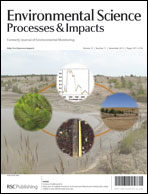Assessment of mercury bioavailability to benthic macroinvertebrates using diffusive gradients in thin films (DGT)†
Abstract
Mercury-specific diffusive gradient in thin films (DGTs) were used in laboratory microcosms as a biomonitoring tool to assess the lability of mercury (Hg) total and monomethylmercury Hg (MeHg), and to develop a relationship between chemical lability and bioavailability in estuarine sediments. Time-series deployment of DGTs in sediments showed that sediment-bound MeHg is more labile than sediment-bound inorganic Hg. In subsequent experiments, DGTs were deployed simultaneously with three benthic macroinvertebrates (the estuarine amphipod, Leptocheirus plumulosus; the estuarine polychaete, Nereis virens; and the marine clam, Macoma nasuta) in sediments for up to 55 days. All organisms and their co-deployed DGTs exhibited an initial period of rapid Hg uptake followed by slower uptake reaching apparent steady state. Strong correlative relationships were generally observed between paddle-type DGTs and macroinvertebrate tissue data (r2 between 0.57 and 0.97). Further, %MeHg:Total Hg ratios for M. nasuta and N. virens (38.5 ± 12.2 and 19.2 ± 5.2) were similar to their corresponding ratios for the DGTs (33.1 ± 13.3 and 24.4 ± 11.0), and they were significantly higher than the same ratios for sediment (2.9 ± 0.3) and pore water (8.5 ± 4.9). The %MeHg:Total Hg ratios for L. plumulosus (68.5 ± 6.2) were significantly higher than those for the DGTs. This may be because the tissue and DGT data for this organism were not truly co-located as L. plumulosus burrows close to the sediment surface, and the DGTs sampled the sediment surface. Overall, our results suggest that for benthic macroinvertebrates in estuarine sediments studied here, (a) sediment MeHg is more bioavailable than inorganic Hg, (b) sediment and pore-water concentration measurements are not good predictors for the extent of bioaccumulation of Hg species, and (c) DGTs are an effective biomonitoring tool for the assessment of bioavailability of Hg species.


 Please wait while we load your content...
Please wait while we load your content...